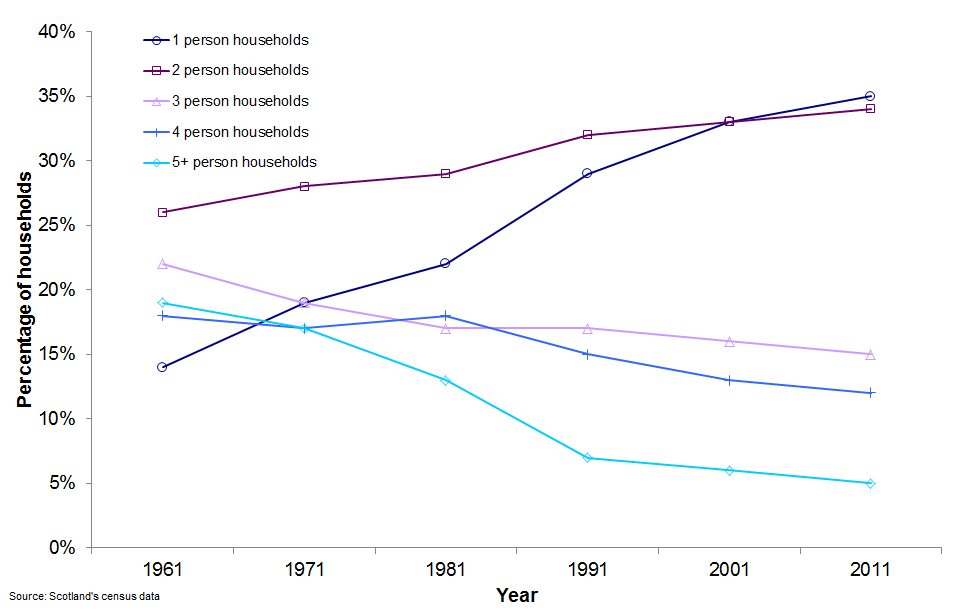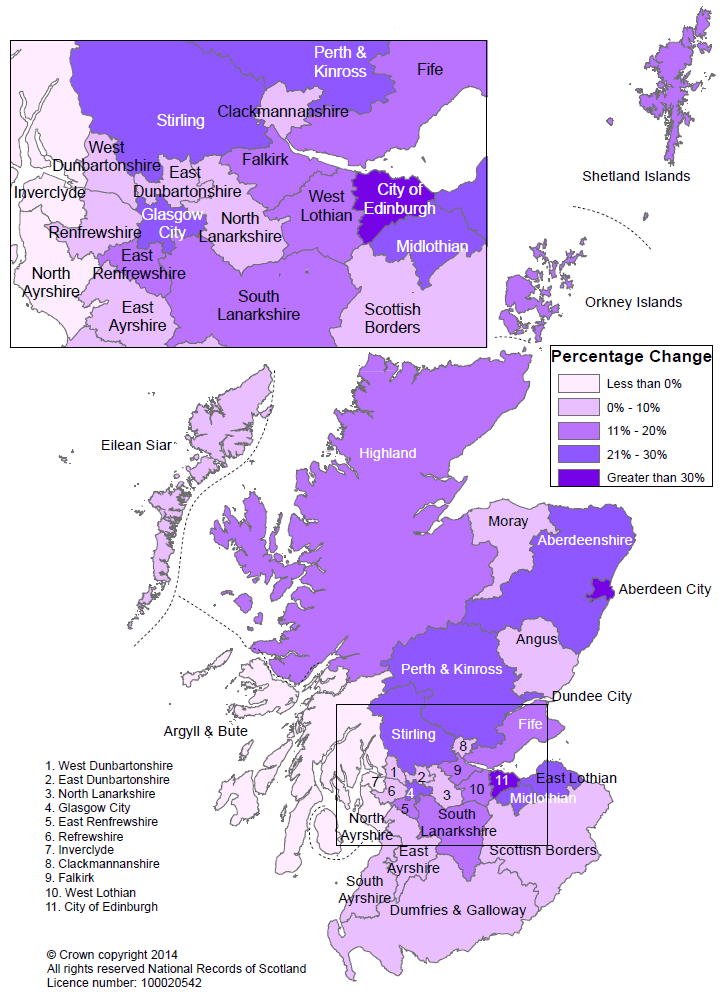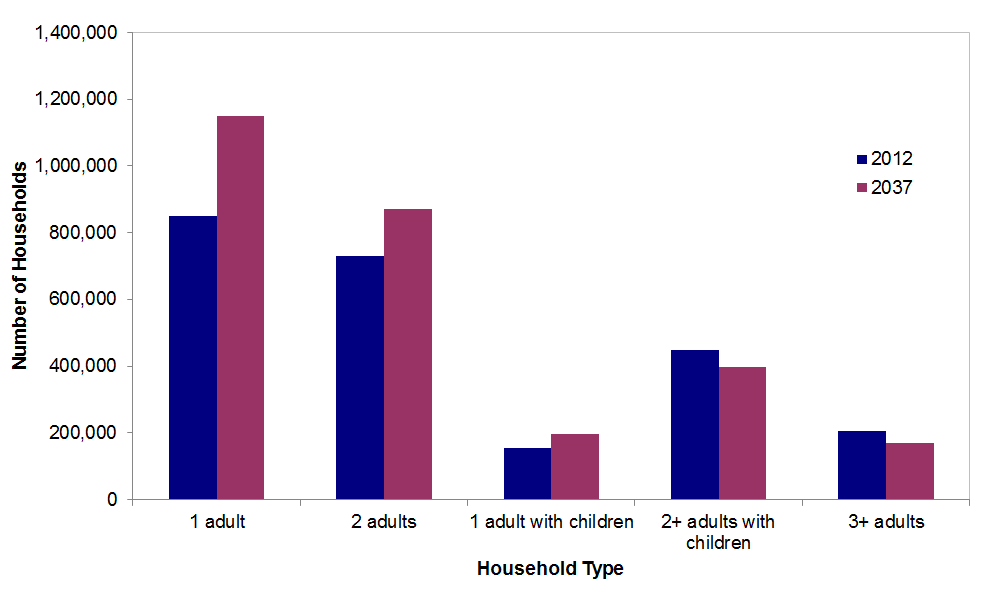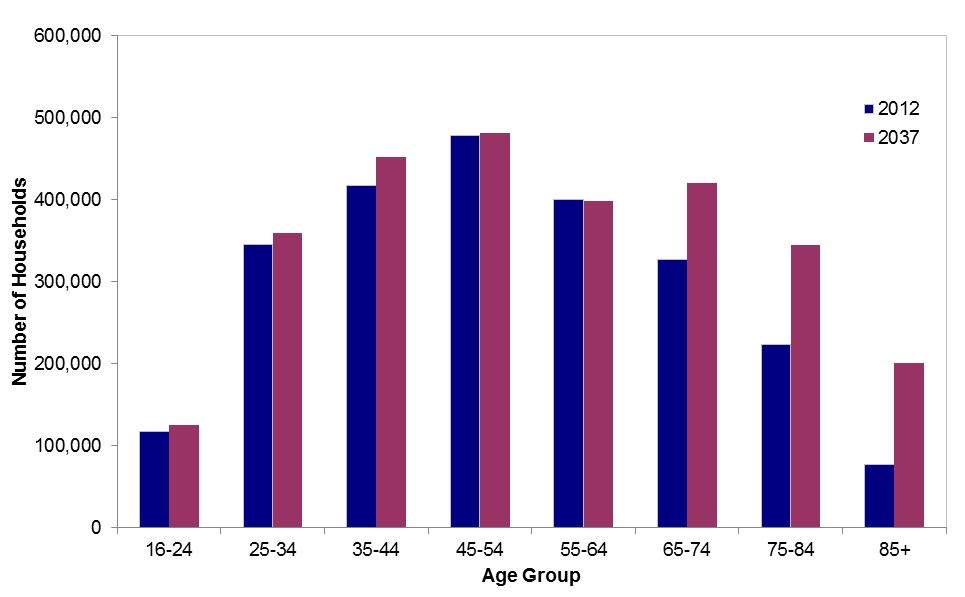In 2013, there were 2.4 million households in Scotland and 2.5 million dwellings. By 2037, the number of households in Scotland is projected to increase to 2.78 million, which is an average increase of around 15,800 households per year. This is the result of an ageing population and more people living alone or in smaller households, as well as an increase in the population. Looking to the future, there is a projected increase in the number of people in older age groups (65+), with a small fall in the number of younger people (16- 64). This has an impact on household structure, as elderly people are more likely to live alone or with just one other person.
Average household sizes are falling, as more people live alone or in smaller households, though the rate of change is slowing down, as shown in Figure 8.1. All Council areas saw a decrease in average household size over the last decade. The average household size decreased from 2.23 people per household in 2003 to 2.18 people per household in 2013 and is projected to fall to 2.03 by 2037.

Across Scotland, 2.8 per cent of dwellings are vacant and 1.4 per cent are second homes. Remote rural areas have the highest percentage of dwellings that are vacant and second homes (4.9 and 6.8 per cent respectively, compared to 2.6 and 0.9 per cent in large urban areas). The proportion of vacant dwellings is generally higher in more deprived areas (4.1 per cent in the most deprived areas compared to 1.6 per cent in the least deprived areas).
Over the last 10 years, there has been an increase in the number of households in all Council areas. The areas with the greatest increase over the last 10 years in percentage terms have been the Orkney Islands (an increase of 16 per cent, 1,362 households) and Aberdeenshire (an increase of 14 per cent, 13,364 households). The City of Edinburgh has seen the largest increase in terms of absolute numbers (19,241 households, an increase of 9 per cent).
The majority of Council areas are projected to continue to have increasing numbers of households. The largest projected increases between 2012 and 2037 are in the City of Edinburgh (39 per cent), Aberdeen City (35 per cent), Perth and Kinross (27 per cent) and East Lothian (27 per cent). In contrast, three Council areas are projected to have a fall in household numbers. These Councils areas are Inverclyde (10 per cent), Argyll and Bute (6 per cent) and North Ayrshire (1 per cent).
Figure 8.2 shows the projected percentage change in the number of households in each Council area over the 25 year projection period (2012 to 2037).
Figure 8.3 shows the projected number of households of each type for 2012 and 2037. There is a large projected increase in households containing just one adult (rising by 41 per cent between 2012 and 2037). There are also increases in households with two adults (a projected increase of 19 per cent) and households with one adult with children (a projected increase of 27 per cent).
In contrast, the number of larger households is falling, with households containing two or more adults with children projected to decrease by around 11 per cent between 2012 and 2037. Households with three or more adults are projected to fall by 17 per cent.
More deprived areas generally contain more households with just one adult (with or without children). This ranges from over half of all households being of this type in the 10 per cent most deprived areas, to just over a quarter of households in the least deprived areas. In contrast, there are more two-adult households (where there is the potential for both adults to be earning), in the less deprived areas.


Figure 8.4 shows the projected number of households in 2012 and 2037, by the age of the head of household. The 'head of household' is the first person included on the census form, unless that person was aged under 16 or was not usually resident in the household.
Scotland's population is ageing, with a projected increase in the number of people in the older age groups. This trend is reflected in the projected number of households, with the largest increases found in households headed by people aged 65 or over, an increase of 54 per cent, from 628,000 to 966,000 between 2012 and 2037. The increases in household numbers are even more striking when focussing on those aged 85 or over. The number of households headed by someone in this age group is projected to more than double from 77,400 to just over 200,000.
In contrast, households headed by someone aged under 65 are only projected to increase by three per cent, to around 1.82 million. However, unlike those aged 65 or over, the number of people aged 16 to 64 in the population is projected to decrease in the population projections.

More detailed information about Scotland's households and housing, including estimates and projections can be found in the households section of the NRS website.
Footnotes: